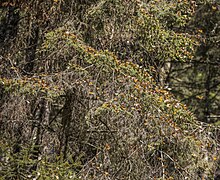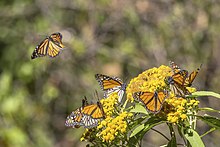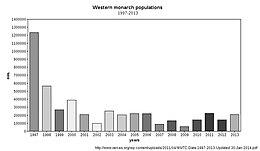Monarch butterfly migration
They remain in roosts atop volcanic mountains on oyamel fir trees (Abies religiosa) during the winter months and then begin their northern migration in March, back to North America and southern Canada.
[17]: 1 As of 2023, one of the larger known overwintering sites was in the Joya Redonda Monarch Butterfly Sanctuary, located 50 miles (80 km) southeast of Mexico City, in the foothills of the volcanoes Popocatépetl and Ixtaccíhuatl in the state of México's municipality of Atlautla.
Although area residents had earlier seen small numbers of monarchs, more butterflies began to establish colonies in Atlautla during the early 2000s as deforestation to the northwest destroyed old hibernation grounds.
[18] Although the exact dates change each year, by the end of October, the population of monarchs east of the Rocky Mountains migrates to the sanctuaries of the Mariposa Monarca Biosphere Reserve within the Trans-Mexican Volcanic Belt pine-oak forests in the Mexican states of Michoacán and México.
These include the angle of light coming from the sun, the senescence of larval host milkweed plants, the decreasing day period and temperature drop.
[40] In California, monarchs have been observed roosting in a wide variety of locations: Fremont, Natural Bridges State Beach, golf courses, suburban areas.
The western population of migrating monarchs overwinters in coastal sites in central and southern California, United States, notably in Pacific Grove, Santa Cruz, and Grover Beach.
[51] In 2013, a flock of painted lady butterflies crossed the Atlantic Ocean from Africa to French Guiana in South America in a non-stop journey of at least 2,600 miles (4,200 km) aided by easterly trade winds.
[52] In 1950, individual swarms of the desert locust (Schistocerca gregaria) were seen migrating from the Arabian peninsula for over 5,000 kilometres (3,107 mi) to the west coast of Africa in seven weeks.
[59][60] An unusual pattern has been observed in the sex ratios of monarchs in the eastern North American population, both during the fall migration and at the overwintering sites in Mexico.
[94] Various studies have shown this behavior both in natural systems and laboratory settings,[93][94][95] yet there remains much to be researched about the underlying mechanisms for interpreting the orientation and timing cues that lead to the migratory patterns of the monarchs.
[97] However, when these monarchs were placed into flight simulators with six hour clock advances or delays, preferred direction of travel changed due to interference with the time-compensated sun compass.
While neural processing occurs in the monarch's brain, research indicates that the actual circadian clock underlying the migratory patterns is located in the butterfly's antennae.
RNA-sequencing differences found between the fall and spring butterflies is one avenue of research that could locate the mechanism responsible for the recalibration, which may utilize a temperature sensor to start the switch.
Adrian Wenner, professor emeritus of natural history at the University of California, Santa Barbara[117]There is debate between researchers and citizen scientists who study the migration regarding the possible local extinction of the Monarch.
[125] Historical conservation regulations began when the residents of Pacific Grove, CA passed an ordinance prohibiting the disturbance of the "peaceful occupation of the Monarch butterflies".
[132] These conservationists argue that the reduction in milkweed habitat in agricultural regions of North America is a major cause of the declines in the number of monarchs that reach Mexico.
[132] By 2018, however, a study correlated monarch butterfly decline to the fact that 95% of corn and soybean crops grown in the United States were using genetically modified seeds resistant to the herbicide glyphosate.
Air application of the herbicide meant that the unplowed margins between field and road that previously supported milkweed and a range of nectar flowers were now greatly diminished.
[87][page needed][137][138][139] Other factors that may have a negative effect on the migration are extreme weather, including colder winters in central Mexico, droughts in Texas, invasive (non—milkweed) flora on which monarchs lay eggs and the increased use of synthetic insecticides that are less biodegradable.
Laws and regulations regarding the protection of the overwintering sites and habitat override the interests of land owners, farmer' cooperatives and local governing bodies.
Joel Berger, University of Nevada[152]Indigenous people, residents, farmers, and landowners surrounding the overwintering sites have made statements about their dissatisfaction with the involvement of Canadian and American conservationists concerning the enforcement of restricting the use of lands in and around preserves.
– Roberto Solis, Instituto Nacional de Ecologia, Mexico[17]: 11 Animal research in conservation has a role but it has little significance unless sociological, economic and political issues are satisfactorily resolved.
[147] On June 20, 2014, President Barack Obama issued a presidential memorandum entitled "Creating a Federal Strategy to Promote the Health of Honey Bees and Other Pollinators".
Beginning in March 2015, those performance requirements and their updates have included four primary aspects for planting designs that are intended to provide adequate on-site foraging opportunities for targeted pollinators.
The attachment described specific actions that would address the incorporation of pollinator-friendly landscaping design and maintenance into new construction and major renovations, existing sites, contracts, leases and occupancy agreements, and education/outreach programs.
The memorandum containing the attachment directed the USDI's bureaus and offices (which include the Bureau of Land Management and the National Park Service) to implement those actions to the extent that they are appropriate for, and consistent with, the mission and function of the facility/site.
That Plan provided examples of past, ongoing, and possible future collaborations between the federal government and non-federal institutions to support pollinator health under each of the National Strategy's goals.
[170] The USDA's Farm Service Agency helps increase U.S. populations of monarch butterfly and other pollinators through its Conservation Reserve Program's State Acres for Wildlife Enhancement (SAFE) Initiative.
Among other things, the initiative encourages landowners to establish wetlands, grasses, and trees to create habitats for species that the FWS has designated to be threatened or endangered.


Piedra Herrada, Mexico

Piedra Herrada, Mexico






